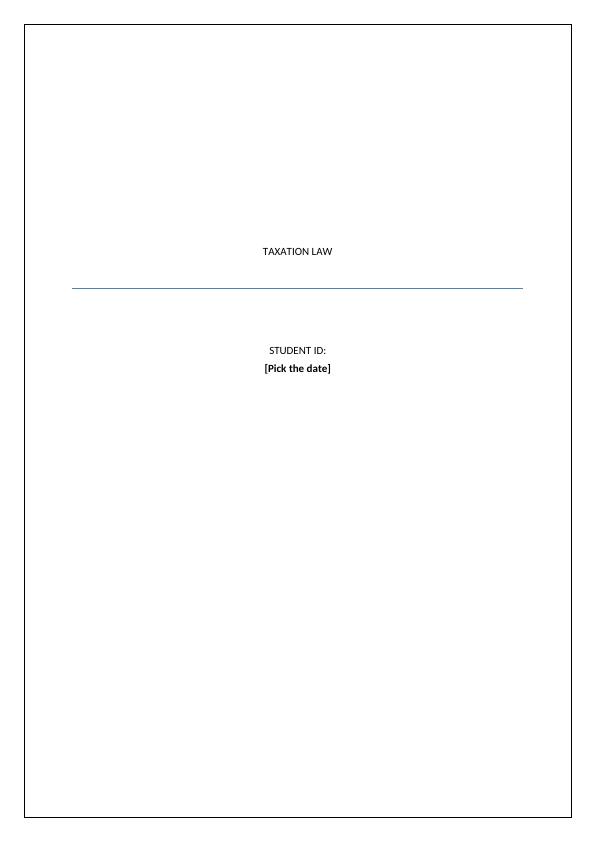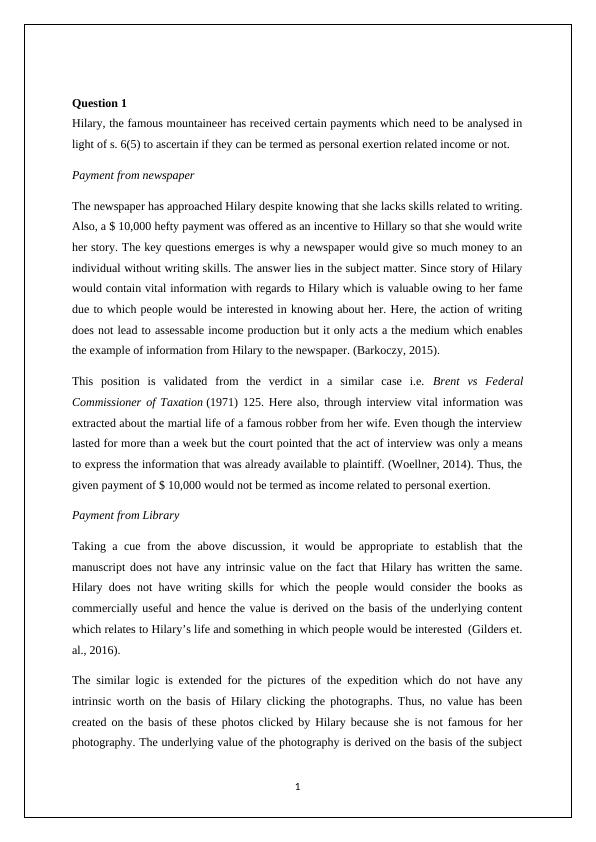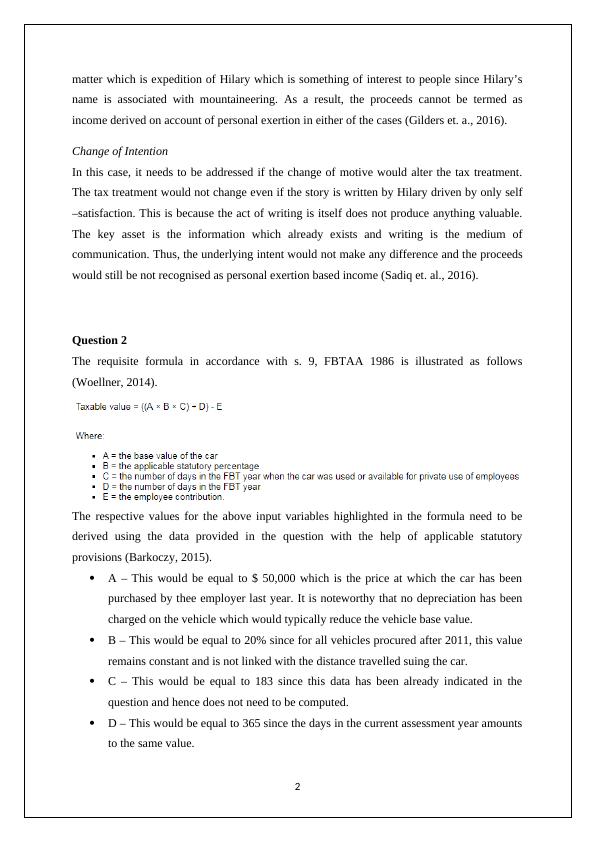Analysis of Payments under Taxation Law
Added on 2023-06-11
8 Pages2342 Words172 Views
TAXATION LAW
STUDENT ID:
[Pick the date]
STUDENT ID:
[Pick the date]

Question 1
Hilary, the famous mountaineer has received certain payments which need to be analysed in
light of s. 6(5) to ascertain if they can be termed as personal exertion related income or not.
Payment from newspaper
The newspaper has approached Hilary despite knowing that she lacks skills related to writing.
Also, a $ 10,000 hefty payment was offered as an incentive to Hillary so that she would write
her story. The key questions emerges is why a newspaper would give so much money to an
individual without writing skills. The answer lies in the subject matter. Since story of Hilary
would contain vital information with regards to Hilary which is valuable owing to her fame
due to which people would be interested in knowing about her. Here, the action of writing
does not lead to assessable income production but it only acts a the medium which enables
the example of information from Hilary to the newspaper. (Barkoczy, 2015).
This position is validated from the verdict in a similar case i.e. Brent vs Federal
Commissioner of Taxation (1971) 125. Here also, through interview vital information was
extracted about the martial life of a famous robber from her wife. Even though the interview
lasted for more than a week but the court pointed that the act of interview was only a means
to express the information that was already available to plaintiff. (Woellner, 2014). Thus, the
given payment of $ 10,000 would not be termed as income related to personal exertion.
Payment from Library
Taking a cue from the above discussion, it would be appropriate to establish that the
manuscript does not have any intrinsic value on the fact that Hilary has written the same.
Hilary does not have writing skills for which the people would consider the books as
commercially useful and hence the value is derived on the basis of the underlying content
which relates to Hilary’s life and something in which people would be interested (Gilders et.
al., 2016).
The similar logic is extended for the pictures of the expedition which do not have any
intrinsic worth on the basis of Hilary clicking the photographs. Thus, no value has been
created on the basis of these photos clicked by Hilary because she is not famous for her
photography. The underlying value of the photography is derived on the basis of the subject
1
Hilary, the famous mountaineer has received certain payments which need to be analysed in
light of s. 6(5) to ascertain if they can be termed as personal exertion related income or not.
Payment from newspaper
The newspaper has approached Hilary despite knowing that she lacks skills related to writing.
Also, a $ 10,000 hefty payment was offered as an incentive to Hillary so that she would write
her story. The key questions emerges is why a newspaper would give so much money to an
individual without writing skills. The answer lies in the subject matter. Since story of Hilary
would contain vital information with regards to Hilary which is valuable owing to her fame
due to which people would be interested in knowing about her. Here, the action of writing
does not lead to assessable income production but it only acts a the medium which enables
the example of information from Hilary to the newspaper. (Barkoczy, 2015).
This position is validated from the verdict in a similar case i.e. Brent vs Federal
Commissioner of Taxation (1971) 125. Here also, through interview vital information was
extracted about the martial life of a famous robber from her wife. Even though the interview
lasted for more than a week but the court pointed that the act of interview was only a means
to express the information that was already available to plaintiff. (Woellner, 2014). Thus, the
given payment of $ 10,000 would not be termed as income related to personal exertion.
Payment from Library
Taking a cue from the above discussion, it would be appropriate to establish that the
manuscript does not have any intrinsic value on the fact that Hilary has written the same.
Hilary does not have writing skills for which the people would consider the books as
commercially useful and hence the value is derived on the basis of the underlying content
which relates to Hilary’s life and something in which people would be interested (Gilders et.
al., 2016).
The similar logic is extended for the pictures of the expedition which do not have any
intrinsic worth on the basis of Hilary clicking the photographs. Thus, no value has been
created on the basis of these photos clicked by Hilary because she is not famous for her
photography. The underlying value of the photography is derived on the basis of the subject
1

matter which is expedition of Hilary which is something of interest to people since Hilary’s
name is associated with mountaineering. As a result, the proceeds cannot be termed as
income derived on account of personal exertion in either of the cases (Gilders et. a., 2016).
Change of Intention
In this case, it needs to be addressed if the change of motive would alter the tax treatment.
The tax treatment would not change even if the story is written by Hilary driven by only self
–satisfaction. This is because the act of writing is itself does not produce anything valuable.
The key asset is the information which already exists and writing is the medium of
communication. Thus, the underlying intent would not make any difference and the proceeds
would still be not recognised as personal exertion based income (Sadiq et. al., 2016).
Question 2
The requisite formula in accordance with s. 9, FBTAA 1986 is illustrated as follows
(Woellner, 2014).
The respective values for the above input variables highlighted in the formula need to be
derived using the data provided in the question with the help of applicable statutory
provisions (Barkoczy, 2015).
A – This would be equal to $ 50,000 which is the price at which the car has been
purchased by thee employer last year. It is noteworthy that no depreciation has been
charged on the vehicle which would typically reduce the vehicle base value.
B – This would be equal to 20% since for all vehicles procured after 2011, this value
remains constant and is not linked with the distance travelled suing the car.
C – This would be equal to 183 since this data has been already indicated in the
question and hence does not need to be computed.
D – This would be equal to 365 since the days in the current assessment year amounts
to the same value.
2
name is associated with mountaineering. As a result, the proceeds cannot be termed as
income derived on account of personal exertion in either of the cases (Gilders et. a., 2016).
Change of Intention
In this case, it needs to be addressed if the change of motive would alter the tax treatment.
The tax treatment would not change even if the story is written by Hilary driven by only self
–satisfaction. This is because the act of writing is itself does not produce anything valuable.
The key asset is the information which already exists and writing is the medium of
communication. Thus, the underlying intent would not make any difference and the proceeds
would still be not recognised as personal exertion based income (Sadiq et. al., 2016).
Question 2
The requisite formula in accordance with s. 9, FBTAA 1986 is illustrated as follows
(Woellner, 2014).
The respective values for the above input variables highlighted in the formula need to be
derived using the data provided in the question with the help of applicable statutory
provisions (Barkoczy, 2015).
A – This would be equal to $ 50,000 which is the price at which the car has been
purchased by thee employer last year. It is noteworthy that no depreciation has been
charged on the vehicle which would typically reduce the vehicle base value.
B – This would be equal to 20% since for all vehicles procured after 2011, this value
remains constant and is not linked with the distance travelled suing the car.
C – This would be equal to 183 since this data has been already indicated in the
question and hence does not need to be computed.
D – This would be equal to 365 since the days in the current assessment year amounts
to the same value.
2

End of preview
Want to access all the pages? Upload your documents or become a member.
Related Documents
Taxation Law: Payments from personal exertion, car fringe benefit, financial assistance, and CGT computationlg...
|7
|1916
|196
Assignment - Taxation Law (Solution)lg...
|7
|1892
|87
Taxation Law: Income Assessment, Car Fringe Benefit, Loan Tax Treatment, Capital Gains Taxlg...
|8
|2345
|193
Taxation Law: Personal Exertion Income, Car Fringe Benefit, Capital Gains Tax, and Gift Taxlg...
|7
|1900
|277
Taxation Law ITAA 1997 - Doclg...
|6
|1596
|50
Taxation Law Issues: Assignmentlg...
|8
|1915
|44
